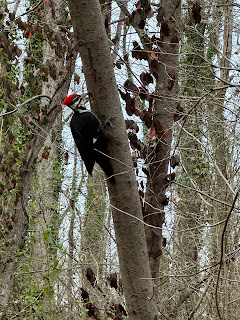Classification & Taxonomy - Exploring Similarities
Learning about how to properly classify different species is a fun way to find similarities between different forms of life!
Let's take a species native to Pony Pasture for example - the Pileated Woodpecker!
This is a large black and white woodpecker most distinctively known for its red crest which makes them easy to spot.
The Classification for the Pileated Woodpecker is as follows:
Domain: Eukaryota - meaning the organisms's cell have a membrane-bound nucleus
Kingom: Animalia - multicellular organisms who (with few exceptions) consume organic material, breathe oxygen, are able to move, and reproduce sexually.
Phylum: Chordata - these animals possess a hollow dorsal nerve chord (notochord), an endostyle or thyroid, pharyngeal slits (nostrils), and a tail.
Class: Aves - essentially birds. They are characterized by feathers, toothless, beaked jaws, laying hard-shelled eggs, a four chambered heart, and a strong (but lightweight) skeleton.
Order: Piciformes - these are birds that generally eat insects, and most have two forward and two backward toes (zygodactyl feet). Most of these birds do not have down feathers at any age - only true feathers.
Family: Picidae - this family is all woodpeckers (including sapsuckers). They're separated out by their foraging behavior. They forage for insects on the trunks and branches of trees, and communicate by drumming with their beaks against tree trunks. They normally nest in holes that they excavate out of trees.
Genus: Dryocopus - this genus is specific to large woodpeckers (usually 35-45 cm in length). They are mainly black with red crowns on their heads. They mostly live in forested areas and they excavate new holes almost annually to roost.
Species: pileatus - this species is specific to the Pileated Woodpecker and its uniqued characteristics. Adults are 40-499 cm long. They are mainly black with a red crest and have a white line down the sides of its throat. They have white on their wings in flights. They inhabit wooded areas across Canada and the Eastern United States, preferring large, mature hardwood trees.
When referring to the Pileated Woodpecker's "scientific name" you'd use just the Genus and Species: Drycopus pileatus
This exploration can be applied to all species as you explore Pony Pasture - you may find that plants and animals that look totally alien from one another may have more in common than you think!



Comments
Post a Comment